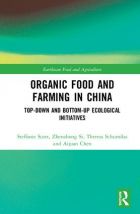Organic Food and Farming in China: Top-down and Bottom-up Ecological Initiatives

As the title of this book implies, the authors examine the growth of ecological farming and alternative food networks in China from two perspectives – those sponsored in a top down manner by the state and those arising from the bottom up through the efforts of farmers, organizers, consumers and other actors. What emerges is a portrait of the movement towards sustainable food and farming in China today.
The book is organized accordingly, with one chapter focusing on state support for ecological and organic agriculture and another on the farmers’ cooperative model in the agricultural sector. Most of the rest of the book is devoted to bottom-up perspectives. The latter includes discussion of the emergence of alternative food networks (AFNs), farmers’ markets as contested spaces and the New Rural Reconstruction Movement. There is also an early chapter on transformations in China’s food system – which provides an overview of changing food consumption patterns, changes in the country’s food retailing system, and an analysis of recent food and agricultural policies.
Having recognized the high environmental costs of conventional agriculture, the Chinese government is providing support to sustainable agriculture through policies and initiatives at central, provincial and local levels. Yet as the authors point out, food security and promotion of an industrial agriculture model remain the top priorities for the state. Moreover, there are important gaps in policies, which currently privilege large farms while excluding smallholders, isolate agriculture from larger food system issues, ignore social justice, and prevent ecological agriculture and alternative food networks from playing a more transformative role in Chinese society.
From the point of view of consumers – principally those in urban areas – the key impetus for the growth of alternative food networks in China is concern about obtaining safe, healthy food. The many safety scandals that the country has witnessed in recent decades has imparted a strong scepticism towards many domestically produced foods, and a willingness among China’s growing middle classes to seek out and even pay higher prices for what they perceive as safer foods. By contrast, the environment, social justice, and the importance of local and seasonal foods have not been important concerns for the vast majority of Chinese consumers.
One of the strongest aspects of the book is its frank exploration of the multiple contradictions that characterize the growth of ecological food and farming initiatives in China. For instance, the Chinese state has been supporting the development of organic agriculture through infrastructural and other investments (e.g. subsidies to cover the costs of certification and the construction of greenhouses), even as officials express concern about the potential for organic agriculture to undermine food security by reducing productivity. In the case of community-supported agriculture (CSA), the operators of many CSA farms tend to be well educated and often exclude peasants from decision making processes on their farms. Another contradiction is the wide gap in values between the organizers of alternative food networks and their customers.
The authors characterize state-led and bottom-up initiatives as “two parallel but disconnected worlds, with very different levels of political and economic power”. While both are playing active roles in promoting ecological agriculture and sustainable food in China, their goals, approaches and understandings differ markedly. At this critical stage in China’s transition towards more sustainable forms of development, the interplay between these two worlds will be crucial in determining how China’s agriculture and food systems evolve in the future.
Book note prepared by Seth Cook
Search the Book notes database
Our Book notes database contains details and summaries of all the publications included in Book notes since 1993 - with details on how to obtain/download.
Use the search form above, or visit the Book notes landing page for more options and latest content.
For a searchable database for papers in Environment and Urbanization, go to http://eau.sagepub.com/

